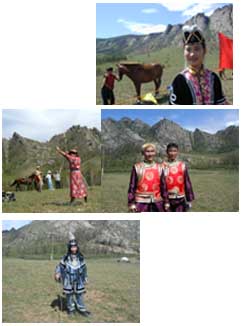|
(they were very lenient about letting us photograph inside
their temple)
we met
with the wife of the head monk.
She spoke to us (with Gerrel translating)
about her monastery and school. The monastery opened in 1991 as
the first (and
only) women’s
monastery in Mongolia.
The women go to India or Tibet for their education.
They are members of the “red sect’ of Buddhism
(she says the “yellow sect” has
the same purpose but with a different road).We then were able to
ask her questions. Some of the more pertinent
questions
and answers were as follows:
Q: What do you call a
woman monk?
A: A male monk is
called “lum” and a woman monk is called “handi ma”.
Q: How do you equate
the asceticism of Buddhism with the elaborate buildings
and other
accoutrement of your
temples? (Somehow I think we were focusing on the way
she was dressed).
A: Buddhist beliefs
include 100s of gods, etc. The believers use only the best in
order to worship and to glorify their gods. Most of the material goods
are given
to them and they don’t use them for themselves, only for the benefit of
their gods.
Q: Why do individual
monks have cell phones, etc?
A: Has to do with
the seven levels of monks. Different levels require different levels of
commitment like celibacy. Lower level monks can marry, father children
and lead
normal lives outside the temple.
Q: Once you begin the
road as a monk, how difficult is it to quit?
A: Not difficult.
Some examples of the different levels include Getil (sp?) this rank
has 37 things that you are required not to do. Gelig (sp?) rank which has
203 things
not to do. They have had one woman who reached the top rank and then
decided
not to go on and returned to normal life.
Q: Where does sin fit
into Buddhism?
A: The yellow and
red sects differ on this question. The yellow sect believes since
the mother suffers, one is born in sin (original sin) and the red sect
believes that
we are born without sin until we are of an accountable age (acquired sin).
Q: Is the ultimate
goal of Buddhism to not be reborn again?
A: No. Buddhists
believe you are reborn hundreds of times and that if you are bad in
a past life it affects how you are born in this life (street people vs.
Bill Gates). Also,
every time you overcome problems it is a form of rebirth. Also there are
6 creatures in
Buddhism and the human one is not the highest creature.
Q: How do you feel
about missionaries coming to Mongolia and the size of the new,
large Vatican embassy or cathedral’s size compared to the size of your
temple.
A: No problems with
the missionaries as Buddhists teach not to fight with each other.
Also, so many people have no belief, the Christian missionaries can teach
at least the
10 commandments.
Q: Tell us about
your school.
A: The school is a
Russian school. I graduated from Russian high school and went to
Russia to study education. The first purpose of the school is to teach
about the world.
The second purpose of the school is to teach the children not to worry
about killing and
the bad things that go on in the world and to love themselves, love their
families and
their country. The school has been open one year and has 80 students.
It currently
has only 1st and 2nd grades. Russian language only
is taught through the 4th grade and
then children can choose their language of study.
It was an interesting
coincidence that this woman knows Gerrel’s mother quite well
because Gerrel’s mom is in charge of Russian language education in Ulan
Bataar.
We then visited the
school and gave the teacher supplies for the students. We also
collected US dollars and made a monetary contribution to the school also.
She asked
for a list of all our names and will put it into a scroll for prayers for
our health and
happiness.
Second stop was the
Natural History Museum where we only had time to rush off to
see the largest dinosaur bones or to visit one or two of the museum’s
shops.
Next we visited the
Choijin Lama Temple Museum (no longer a working temple).
The youngest brother of the 8th Botan (builder of the Winter
Palace) became a lama
and built this temple in 1904. One of the highlights of this visit was
the large bowl for
rice enough to feed 300 monks. Inside the temple itself there are many
Buddhist
tonkas from the 18th and 19th century depicting the
deities of Buddhism. There are
also many fabulous and terrifying masks including those of Jamsaran
(with third eye and skulls in hat), Yellow Dharmapala (red faced), etc.
After a delicious
lunch in a Thai Restaurant and short visit to see the exhibit of
school children’s art on display outside the restaurant, we boarded our
bus once
more for a visit to a woman who makes felts, art felts that has been
displayed in
museums. Her name is Bayan Duuren and we had an excellent afternoon
viewing her work and, of course, buying lots of wonderful hats and other
felted goodies.
Tonight we went to
a folk dance and music show at the Rsuki Center.
There was a giant rain storm and the walls started leaking during the
shaman’s
dance portion of the show. All the electricity went off and the
restaurant had to be
closed down so we were served dinner after the show in the seats we
watched the
show in.
|
